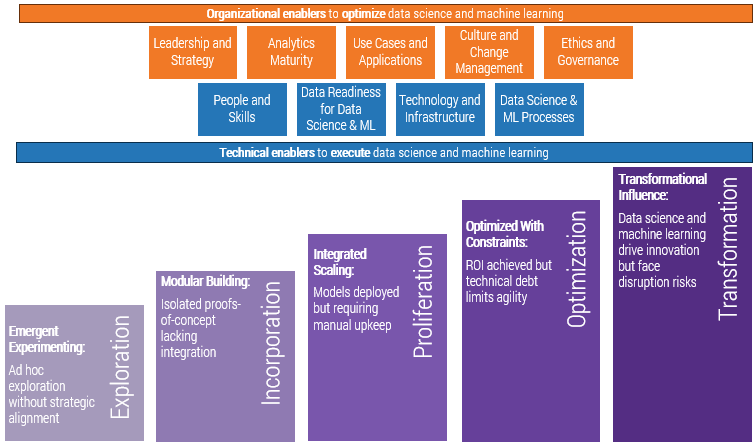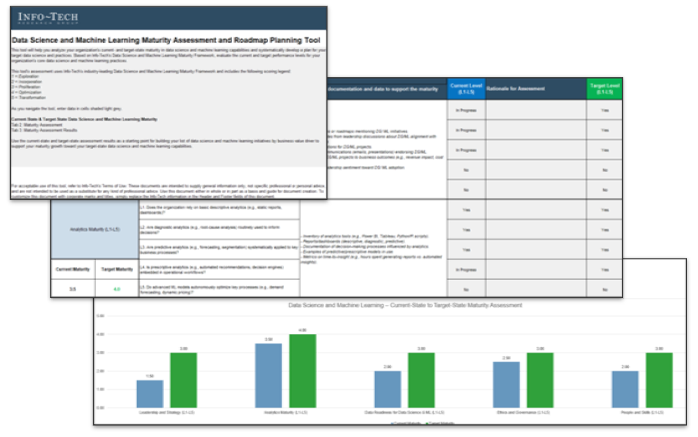Despite substantial investments in AI, many organizations aren’t seeing the payoff. Data science and machine learning (ML) capabilities can play an essential role – they connect people, data, and technology to bring AI to life and help it deliver value. This comprehensive framework will help you assess your organization’s data science and ML capabilities to close the gap between raw data and real organizational value.
A cautious culture, variable data quality, skills gaps, and unreliable analytics present major roadblocks to maximizing the potential of the data science and ML function. By assessing the maturity of their data science capabilities, data leaders can expose and address the relevant gaps, then strike the right balance between off-the-shelf tools and purpose-built solutions to build a foundation for AI that can deliver continuous innovation.
1. Build only what you need.
Not every data science and ML capability needs to be at the highest level of maturity to deliver value. Instead, focus on getting the fundamentals right: solid technical foundations, strong leadership, and a data culture that supports smart, scalable use.
2. Solve the right problem.
Teams often focus too much on symptoms or rush into technical solutions that miss the real problems. Progress relies on clearly defining the problems with an eye on strategic goals and ensuring your data teams are in sync with organizational needs.
3. Culture is the great accelerator.
Even the best data science and ML strategy will stall without the right mindsets and change readiness in place. High maturity in organizational culture and change management accelerates progress in all other capabilities.
Use this step-by-step blueprint to unlock the full potential of data science and machine learning
Our research offers comprehensive guidance and a simple-to-use assessment to help you understand and close the gaps in your data science and ML capabilities. Use this step-by-step framework to develop scalable, value-driving capabilities.
- Formulate well-defined problems aligned to functional objectives to be maximized or minimized.
- Assess data science and ML maturity level to determine the minimal essential maturity level of each capability needed to meet ROI success indicators.
- Determine target state maturity and activities that will improve the effectiveness of each data science and ML capability.
Assess Your Data Science and Machine Learning Capabilities and Effectiveness
Unlock the full potential of AI and data.
Analyst perspective
Bridging AI hype and real value
Data science and machine learning (ML) have incredible potential, but for many organizations they're still more hype than results. Investments in AI are high, yet few companies are truly getting game-changing value. It's no longer a question of "if" but "how" to make data and AI work - those who figure it out will surge ahead, as AI becomes increasingly core to products, decisions, and competitive advantage.
You don't need to reinvent every wheel to succeed with AI. The fastest movers blend bought solutions with in-house talent. In practice, this means adopting proven data science platforms and pre-built tools to accelerate your efforts while your team focuses on tailoring insights to the business. In short, buy the capabilities you can and build what's uniquely yours - this pro-buy stance gets you to value quicker and avoids wasted time on building things that others have already perfected.
Technology alone won't transform your business - people and process will. That's why you need a dedicated data science and ML function in the organization: a team with the skills and mandate to turn data into insight and insight into action. Equally important is assessing your analytics maturity with clear eyes. Understanding your gaps - be it data quality, skills, or culture - lets you target improvements that deliver real value. By combining the right tools (often acquired) with the right internal capabilities (people, process, and leadership support), you create a powerful engine for continuous innovation. The bottom line: success with AI comes from a savvy mix of external solutions and internal strength, all guided by a plan to steadily mature your data science practice and drive tangible business outcomes.

Ibrahim Abdel-Kader
Senior Research Analyst, Data, Analytics, and AI
Info-Tech Research Group
Executive summary
| Your Challenge | Common Obstacles | Info-Tech's Approach |
|
Despite heavy investments, organizations struggle to harness innovation and agility through AI/ML:
Decision-makers lack timely, actionable insights and need to translate raw data into strategic clarity. |
Even when leaders are committed to data science and ML, systemic and cultural hurdles derail progress:
AI initiatives continue to stall out as programs struggle to move from pilot stage to production and profit. |
Our approach moves organizations from ad hoc experiments to scalable, value-driving capabilities:
Institutionalize data science and machine learning as a continual business discipline. |
Info-Tech Insight
Data science and machine learning unlock hidden value by turning raw data into smarter, context-rooted decisions; but success doesn't come from pushing every capability to "Level 5" maturity. It comes from having the right technical foundations (quality data, proper tools and platforms) and organizational enablers (engaged leadership, skilled people, and a supportive data culture) in place.
Organizations are struggling to compete in the era of AI and data
- Organizations today struggle to harness innovation and agility through AI/ML. Despite heavy investments, relatively few are seeing real returns.
- Many companies risk falling behind more advanced rivals who leverage AI to reinvent products and operations.
- At the same time, customers and investors now expect faster, smarter decisions powered by data. Business leaders are inundated with information.
- Counterintuitively, this data abundance often creates noise instead of insight. The sheer volume of data, and uncertainty over which data to trust, has paralyzed decision-making and even halted decisions altogether because the data was overwhelming.
- The challenge for data and tech leaders is to translate raw data into strategic clarity. Executives are making more decisions than ever, under high scrutiny, and they feel the pressure to get them right.
- Bridging that gap, and doing so faster than the competition, is the core challenge in the era where AI is the new currency of competitive advantage.
Companies Gaining AI Value
Only 26% have moved projects beyond pilots to achieve tangible AI/ML value.
Source: Boston Consulting Group (BCG), 2024
Data Overload
72% of leaders have stalled decisions due to overwhelming data.
Source: Oracle, 2023
CEOs Betting on AI
75% of CEOs say advanced AI will determine competitive advantage.
Source: IBM Institute for Business Value, 2023
Progress is stalling despite best intentions
- Traditional decision-making processes and a cautious culture can stifle innovation. Many companies continue to rely on legacy workflows and intuition.
- Employees stick to familiar habits, and management may be reluctant to trust AI-driven insights for critical decisions. This inertia means organizations fail to act on the data they have.
- Fragmented, poor-quality data is a major bottleneck. Enterprises typically have data locked in departmental silos or incompatible systems, with patchy governance. Without unified, clean data, even the best algorithms underperform.
- The misalignment between talent gaps and adoption resistance manifests as hesitation on the ground. Moreover, many employees fear AI could disrupt their jobs or decision-making authority. Without strong change management, people may resist or ignore new DS/ML tools.
- Companies have invested in data platforms and data science talent, but process and people issues are blocking ROI. Siloed data and siloed thinking go hand in hand: if data isn't shared and trusted across the enterprise, and if leaders aren't empowering teams to use it, then fancy algorithms won't matter.
Culture and Process Hurdles
Cultural resistance and outdated processes are cited as the greatest barrier to getting value from data initiatives. 78% of organizations remain stuck in legacy mindsets despite new technology.
Source: Wavestone, 2024
Talent and Adoption Gaps
The fluidity and tenuous nature of the CDO/CDAO role is reflected in the 51% of organizations that view the role as being successful and well-established, while the rest are struggling with turnover or view the role as a failure.
Source: Wavestone, 2024
Info-Tech's approach:
From experimentation to enterprise impact
To overcome these hurdles, Info-Tech recommends treating data science and machine learning not as isolated tech projects but as an integrated business discipline. Our approach is designed to move organizations from ad hoc experiments to scalable, value-driving capabilities:

The Info-Tech difference:
- Start With the Why - Rather than doing AI for AI's sake, begin by determining how DS/ML can propel your specific business objectives.
- Know Your Starting Point - Next, perform an honest maturity assessment of your organization's data science and ML capabilities across people, process, data, and technology.
- Less Is More - With gaps understood, the next step is to identify a targeted portfolio of initiatives to close those gaps and achieve quick wins.
Assess Your Data Science and ML Capabilities Project Overview
Contact your account representative for more information.
workshops@infotech.com 1-888-670-8889
| 1. Assess data science and ML capabilities and effectiveness | Outcome | |
|---|---|---|
| Best-Practice Toolkit |
|
|
| Guided Implementations |
Call 1 - Identify functional objectives to maximize or minimize Call 2 - Develop data science and ML problem statements Call 3 - Define ROI success indicators Call 4 - Assess current-state maturity Call 5 -Determine target-state maturity Call 6 - Identify activities to close maturity gap |
Insight summary
Overarching insight
Data science and machine learning unlock hidden value by turning raw data into smarter, context-rooted decisions - but success doesn't come from pushing every capability to "Level 5" maturity. It comes from having the right technical foundations (quality data, proper tools and platforms) and organizational enablers (engaged leadership, skilled people, and a supportive data culture) in place.
Step 1 insight
Functional owners frequently state a symptom to be the core problem or chase a fancy technical solution that doesn't address any problem at all.
It is imperative that problems are well defined and that there is collaboration between the data and functional teams to get there.
Step 2 insight
Culture is the silent multiplier. High maturity in culture and change management accelerates progress in all other capabilities.
Low maturity here creates friction. For example, resistance to DS/ML adoption may persist despite strong technology.
Step 3 insight
Achieving level 5 maturity should not be an automatic target to strive for, as obsessions over this can derail the potential ROI for data science and machine learning.
Determine the minimum maturity level needed to adequately address the problem and meet ROI success indicators.
Tactical insight
Capabilities mature at different speeds. For example, data readiness often lags behind leadership aspirations.
Tactical insight
Weaknesses in one capability (e.g. ethics) can derail progress in others (e.g. use cases).
Blueprint deliverable
This blueprint is accompanied by this key deliverable to help you accomplish your goals:

Key deliverable:
Data Science and Machine Learning Maturity Assessment Tool
This tool will help you analyze your organization's current- and target-state maturity in data science and machine learning capabilities and systematically develop a plan for your target data science and practices.
Blueprint benefits
| IT Benefits | Business Benefits |
|---|---|
|
|
Source: 1. Accenture, 2024. 2.IDC, 2023

 Build Your AI Solution Selection Criteria
Build Your AI Solution Selection Criteria
 Build a Reporting and Analytical Insights Strategy
Build a Reporting and Analytical Insights Strategy
 Establish Data Governance
Establish Data Governance
 Business Intelligence and Analytics Platform Selection Guide
Business Intelligence and Analytics Platform Selection Guide
 Mitigate Machine Bias
Mitigate Machine Bias
 Get Started With Artificial Intelligence
Get Started With Artificial Intelligence
 Define the Components of Your AI Architecture
Define the Components of Your AI Architecture
 Drive Business Value With Off-the-Shelf AI
Drive Business Value With Off-the-Shelf AI
 Govern the Use of AI Responsibly With a Fit-for-Purpose Structure
Govern the Use of AI Responsibly With a Fit-for-Purpose Structure
 AI Trends 2023
AI Trends 2023
 Data and Analytics Trends 2023
Data and Analytics Trends 2023
 Build Your Generative AI Roadmap
Build Your Generative AI Roadmap
 Tell Your Story With Data Visualization
Tell Your Story With Data Visualization
 Select Your Generative AI Vendor
Select Your Generative AI Vendor
 An AI Primer for Business Leaders
An AI Primer for Business Leaders
 Identify and Select Pilot AI Use Cases
Identify and Select Pilot AI Use Cases
 Design Your AI Target Operating Model
Design Your AI Target Operating Model
 Plan Your Early AI Moves: Training for Business Leaders
Plan Your Early AI Moves: Training for Business Leaders
 Build Your AI Business Case
Build Your AI Business Case
 Run IT By the Numbers
Run IT By the Numbers
 Transform IT, Transform Everything
Transform IT, Transform Everything
 The Race to Develop Talent
The Race to Develop Talent
 Assessing the AI Ecosystem
Assessing the AI Ecosystem
 Sync or Sink: Aligning IT and HR for the Future of Work
Sync or Sink: Aligning IT and HR for the Future of Work
 Bring AI Out of the Shadows
Bring AI Out of the Shadows
 The AI Vendor Landscape in IT
The AI Vendor Landscape in IT
 IT Spend and Staffing Benchmarking
IT Spend and Staffing Benchmarking
 The Data Playbook
The Data Playbook
 Assess Your Data Science and Machine Learning Capabilities
Assess Your Data Science and Machine Learning Capabilities